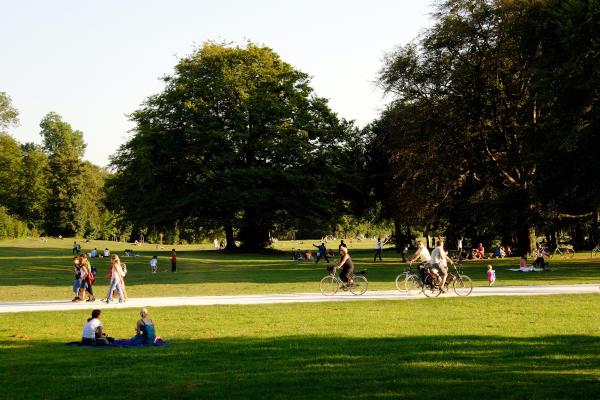Libraries of all types are taking on new roles and responsibilities. Through robust programming agendas, they’re at the center of community-building efforts all across the United States.

As part of the National Impact of Library Public Programs Assessment (NILPPA), Knology sat down with advisors from across the library sector to discuss the impacts libraries aim to have on the communities they serve. During these discussions, we also brainstormed ways to track these impacts across various domains of community life. Two important ideas emerged from our conversations:
- Impact Domains
Specific areas where library programs can make meaningful differences in people’s lives. We defined nine of these. Libraries can help create: (1) connected communities; (2) knowledgeable communities; (3) creative communities; (4) civically engaged communities; (5) healthy communities; (6) economically vital communities; (7) welcoming communities; (8) joyful communities; (9) caring communities.
- Indicators
Ways of measuring the real-world impact of library programming. These Indicators allow us to determine whether or not programs are having their intended effects.
In this series of blog posts, we’d like to talk about each of these impact domains individually, and talk about how libraries are contributing to each of them. In this post, we focus on healthy communities.
What are healthy communities?
By the most straightforward definition, a healthy community is one where all members are able to lead physically and mentally healthy lives. Meeting these needs sometimes depends on medical care, but healthy communities promote wellbeing in a more general sense — for example, through programs focused on nutrition, exercise, or navigating the health system. On a broader level, healthy communities undertake actions aligned with the five “social determinants of health” outlined by the U.S. Department of Health and Human Services: healthcare access, safe living conditions, positive social relationships, financial stability, and access to quality education (HHS, n.d.). Healthy communities take responsibility for individual and collective health. They provide opportunities for community members to learn about health issues affecting them and their community, and work together to improve health outcomes.
Example: Improving Food Security at the Laurel Public Library
The Laurel Public Library in Delaware serves an economically disadvantaged community where 36 percent of the population lives below the federal poverty line. The library has taken an active role in meeting the health needs of their community by providing access to food and hygiene products, as well as offering cooking and nutrition classes. Even while the library was closed due to COVID-19, staff continued to address food insecurity by handing out lunches and setting up carts outside the library stocked with produce and non-perishable goods. Community members were encouraged to contribute supplies if they could, and to take what they needed. Now that the library has re-opened, kids and teens are able to visit the library for a free after-school snack five days a week, and a hot meal three days a week.
In addition to making sure community members have the basic resources they need, the library also offers private space for telehealth appointments and assistance signing up for healthcare and social services. It also arranges for a mobile health clinic to visit once a month.
To learn more about the Laurel Public Library and how they expanded services through ALA grant funding, check out Knology and ALA's case study.
How Can You Make Your Community Healthier?
Providing community members with basic resources like food is a very direct way of improving community health, but this likely requires funding from a grant or community partner. However, there are many other types of programs that can contribute to healthy communities, including:
- Cooking or nutrition classes
- Helping patrons sign up for health insurance, find service providers, etc.
- Collaborating with healthcare providers to offer health check-ups, immunization, and other related services
- Discussions to raise awareness and reduce stigma around mental health
- Opportunities for patrons to engage in physical activity, such as StoryWalks or yoga classes
- Combating health misinformation and helping people identify reliable sources for health information
Let’s Put it To Work!
We’re interested in learning more about how you think libraries can create healthy communities. How do programs at your library support the health of your community? What partnerships do you have that help you meet this goal? And how else might libraries help the communities they serve to thrive physically and mentally?
Let us know what you think about these things. You can either comment below or email programminglibrarian@ala.org. And for more information on this topic, please consult the literature cited below.
References & Additional Resources
Collins, L. N. (2015). Healthy libraries develop healthy communities: Public libraries and their tremendous efforts to support the Affordable Care Act. Journal of consumer health on the Internet, 19(1), 68-76.
Marshall, A., & Henwood, F. (2007). Informing Health: libraries and support for the development of healthy communities.
These materials were produced for National Impact of Library Public Programs Assessment (NILPPA), a project funded by the Institute of Museum and Library Services. The authors are solely responsible for the content on this page.
Written by Knology. This blog has been co-posted on Programming Librarian, NILPPA and the Knology website.
Knology is a nonprofit research organization that produces practical social science for a better world. The organization pursues this goal to help professionals in a variety of sectors build inclusive, informed, and cooperative societies that can thrive together with the natural systems on which we all depend. As a transdisciplinary collective of over 30 social scientists, writers and educators, the organization's work process is built on equity, transparency and deliberation.



